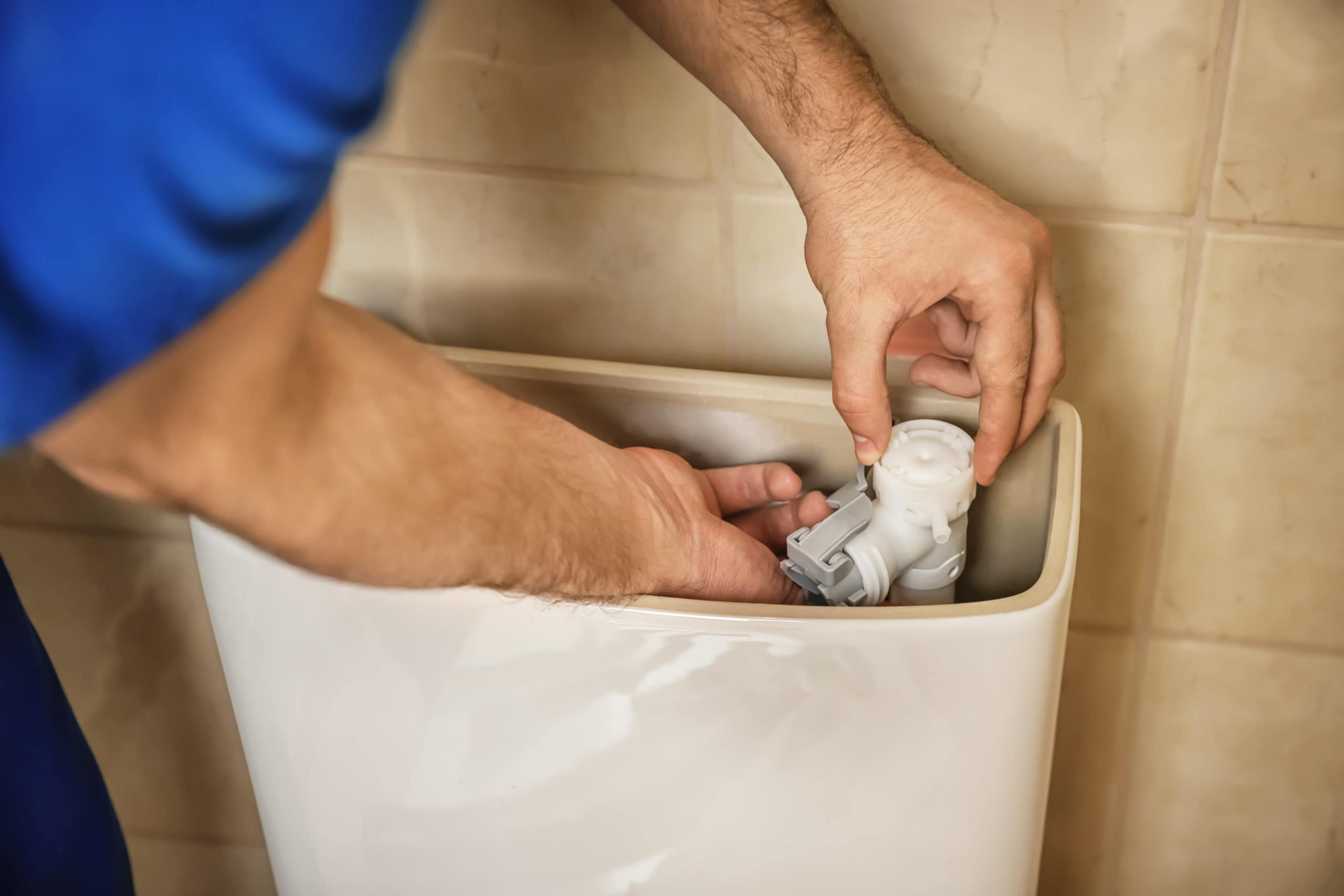Queen Elizabeth 1st godson, Sir John Harington, designed the first flushable toilet. Harington’s pot needed a two-foot-deep oval toilet bowl and 7.5 gallons of water stored on the floor above, which poured through the toilet bowl into a cistern below. It only needed to be flushed after twenty people had used it!
The steps to fix a running toilet without a ball float follow the steps below.
- Check the flapper is working and is adjusted.
- Check the flapper chain.
- Check if the fill valve is out of adjustment or broken.
- Check if the overflow tube is damaged or cracked.
The amount of water lost by a continuously running toilet is massive and will rack up very high utility bills if not rectified. Not only does fixing the toilet reduce the consumption costs, but it is also not expensive and can be accomplished by any enthusiastic DIYer.

How To Stop A Toilet From Constantly Running
The methods needed to stop a toilet from constantly running will depend on the cause of the issue.
These are listed below.
The Flapper Valve Needs Attention
If the flapper valve is worn out, warped, or is dirty and does not seal the toilet tank from the outlet pipe, it needs attention.
The following steps will guide you in the process of resolving this.
Step 1 – Remove The Tank Lid.
Remove the lid and place it on a level surface where it is not at risk of falling or being stood on.
Step 2 – Check The Flapper Chain.
Check the tension of the lift chain.
- If it is too tight, the flapper valve won’t close far enough, and it will not seal.
- If it is too loose and the flapper chain hangs very low, it may get caught underneath the flapper valve and prevent it from sealing against the outlet pipe.
- Check if the flapper chain is not caught up and has free movement to raise and lower the flapper valve.

Step 3 – Check The Flapper Valve
If there is no issue with the flapper chain, carefully press down on the flapper valve and check if it seals the outlet valve and if no water leaks into the bowl.
If the water stops running when you apply pressure, the problem lies with the flapper valve, and you should replace it.
Step 4 – Replace The Flapper Valve
Turn off the toilet tap and flush the remaining water in the tank into the bowl.
Unhook the flapper from the flapper chain and the overflow tube.
Check the condition of the flapper valve and make sure it is clean and that there is no dirt caught around it.
Disconnect the flapper from the flush valve, position the new flapper, and hook it to the flush valve and handle arm.
The Fill Valve Is Out Of Adjustment Or Broken
In modern toilets, a float cup has replaced the older float balls.
The float cup is fitted adjacent to the fill valve assembly, and the system works in the same manner as a float ball and stops the toilet from running when it rises.
If the float cup is in poor condition or the fill valve is out of adjustment or broken, water will run into the tank continuously.
To replace the fill valve, follow the next steps.

Step 1 – Empty The Toilet Tank
Turn off the toilet tap and flush the remaining water in the tank into the bowl.
Take a photograph of how all the tank components are laid out and how they all connect.
Step 2 – Disconnect The Inlet Pipe
Try to unscrew the fill valve unit from the inlet pipe by hand.
As it is made from plastic, it is easy to damage; therefore, only use a wrench as a last resort if you cannot unscrew it by hand.
Step 3 – Detach The Fill Pipe
The fill pipe is normally attached to the tank by a locknut installed underneath the tank.
Unscrew the locknut below the tank, and the fill valve should detach.
Unclip the overflow tube from the refill tube and pull out the fill valve.
Step 4 – Adjust The New Fill Valve
The top of the fill valve must be an inch higher than the top of the overflow tube.
It is possible to adjust this on the fill valve.

Step 5 – Replace The Fill Valve
Replace the fill valve with a new unit, ensuring that the replacement is installed in the same position as the old unit.
Step 6 – Finish Off The Job
Reattach the refill tube and install the locknut below the toilet tank.
Reattach the water supply pipe and turn the tap on, checking carefully for any leaks.
Flush the tank and when it refills, confirm that the water stops flowing.
The Overflow Tube Is Damaged
The overflow tube is the large tube positioned in the middle of the toilet tank.
It pumps excess water to the bowl to prevent the toilet tank from overflowing.
The water should stop filling the tank when the level reaches approximately ½ inch below the top of the overflow tube.
As the fill valve fills the tank with more water, the overflow tube sends it down to the bowl.
If the overflow tube is cracked, it will cause water to run continuously into the toilet bowl.
To replace the Overflow tube, follow the next steps.

Step One – Prepare The Toilet
Turn off the toilet tap and flush the remaining water in the tank into the bowl.
Once again, take a photograph of how all the tank components are laid out and how they all connect.
Step 2 – Disconnect The Inlet Pipe
Try to unscrew the fill valve unit from the inlet pipe by hand.
Once again, as it is made from plastic, it is easily damaged; therefore, only use a wrench as a last resort if you cannot unscrew it by hand.
Step 3 – Disconnect The Internal Toilet Components
Detach the flapper chain from the flapper lever rod inside the tank.
Disconnect the water refill hose from the overflow tube by sliding the anchor hook up and off the overflow.
Unscrew the bolts at the bottom of the tank on each side of the flapper.
You will need to hold the nut (or wing nut) on the bottom of the tank with pliers as the bolt loosens.
Lift the tank off the toilet bowl.

Step 4 – Remove The Overflow Tube
Place the tank on a towel that is on a flat surface.
Take off the rubber gasket of the underside of the tank.
Loosen the large plastic hex nut that was under the gasket. Then remove the nut.
Finally, remove the overflow tube and flapper assembly.
Step 5 – Replace The New Overflow Tube
Reinstall the new overflow and flapper assembly.
Make sure the replacement overflow tube and flapper unit sit flush against the bottom of the tank.
Set up your level up to the line indicated on the fill valve. Make a mark on the overflow tube one inch lower than the mark on the fill valve.
Cut the top of the overflow tube off and clean off the edge of the pipe.
Step 6 – Finish The Project
Reverse the steps and reassemble the toilet.
Why Does The Toilet Keep Running?
Whether you have a flapper handle toilet or a more modern push-button device, if it runs continuously, the cause can normally be traced to the following four components.
- The flapper valve is worn out, warped, or is dirty and not sealing the toilet tank from the outlet pipe.
- The fill valve is out of adjustment or broken.
- The overflow tube is cracked.
- The flapper chain is too tight or stuck.
The latest toilets do not have the ball float and instead replace this with a float cup installed on the side of the fill valve assembly.
Conclusion
Very few things in life are more irritating than the slow water torture of a toilet that won’t stop running. Fixing a constantly running toilet may be as simple as making a small adjustment or replacing one of the toilet components.
If you need to repair any part of the toilet, carefully prepare the parts you need and make sure you have an image of the layout of the toilet components to ensure you can reassemble it correctly.

Amos Christen graduated with a bachelor’s degree in Interior Design from Drexel University — Philadelphia, PA. Since 2003, Amos has worked with top interior design professionals in this area, including architects and interior/graphic/lighting designers. As a skilled interior designer, Amos Christen is highly versed in fine arts and crafts and uses that to supplement his main area of expertise. He often publishes articles related to home décor on several websites, including Sprucetoilets.com, Sprucebathroom.com, and Mybesuitedhome.com. He also contributes to leading interior design magazines.
